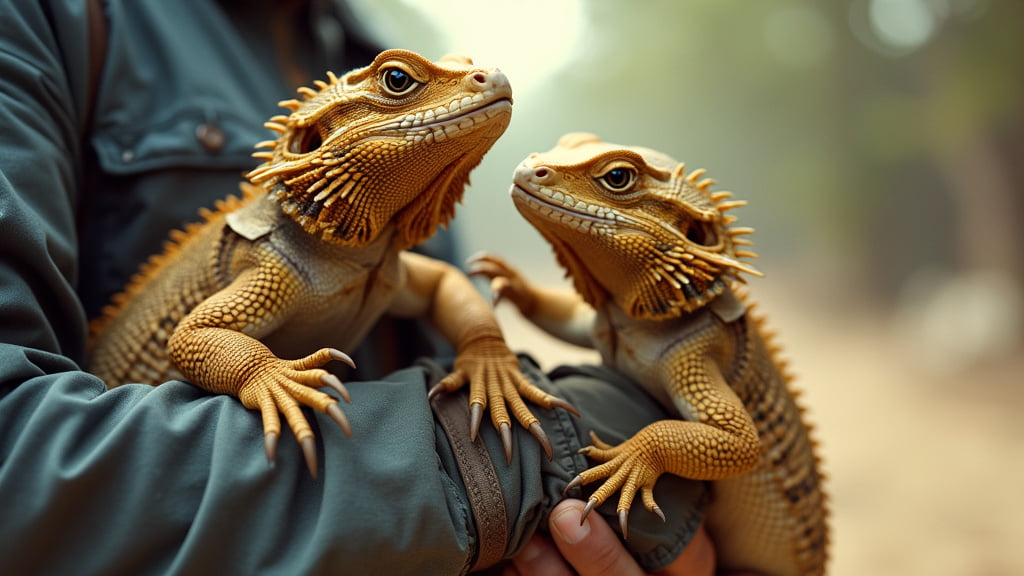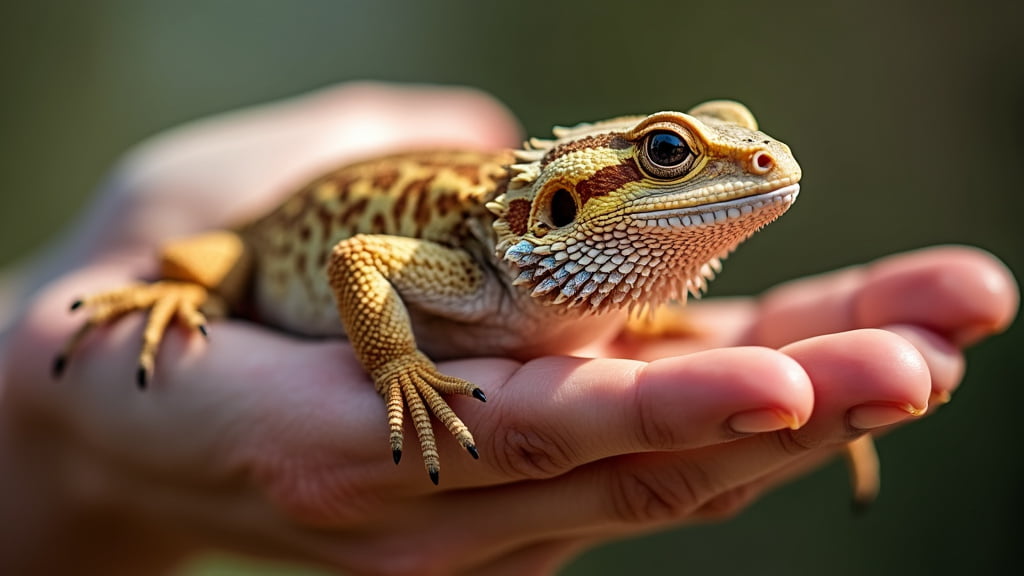Bearded dragons are reptiles native to Australia’s deserts, requiring specific care during travel. These animals need a warm environment with a basking spot temperature of 95-105°F (35-40.5°C) and 10-12 hours of daily UVB light exposure. Their diet consists of insects, leafy greens, and occasional fruits.
Maintaining these conditions is crucial for their health while traveling. Bearded dragons are creatures of habit, thriving on routine and familiar surroundings. Travel can disrupt their normal environment, potentially causing stress and anxiety.
To ensure their well-being during journeys, it’s essential to create a secure and comfortable traveling habitat that mimics their usual living conditions as closely as possible. This approach helps minimize stress and maintains the bearded dragon’s physical and psychological health throughout the trip.
Key Takeaways
- Bearded dragons require a warm and spacious enclosure with proper lighting and hiding spots
- When traveling, prepare a secure and well-ventilated enclosure with familiar bedding and hiding spots
- Choose a transportation method that minimizes stress and provides stability for your bearded dragon
- Maintain proper temperature and lighting in the travel enclosure to ensure your bearded dragon’s comfort
- Offer small amounts of food and water during the journey to keep your bearded dragon hydrated and nourished
- Handle and manage stress during travel by minimizing disturbances and providing a calm environment
- Upon arrival, set up the new enclosure with familiar items and allow your bearded dragon to acclimate to the new environment
Preparing a suitable travel enclosure
Choosing the Right Enclosure
Consider using a sturdy plastic or glass terrarium with a secure lid to provide a safe and secure environment for your bearded dragon.
Substrate and Furnishings
In addition to the size and security of the enclosure, it’s essential to consider the substrate and furnishings inside. Bearded dragons require a substrate that is easy to clean and won’t cause impaction if ingested. Avoid using loose substrates such as sand or gravel, and opt for reptile carpet or paper towels instead. Furnishings like branches, rocks, and hides should also be included to provide a sense of security and stimulation for your bearded dragon during travel.
Ensuring a Safe and Comfortable Journey
By preparing a suitable travel enclosure, you can ensure that your bearded dragon feels safe and comfortable throughout the journey.
Choosing the right transportation method

When traveling with a bearded dragon, it’s important to choose the right transportation method to ensure their safety and well-being. There are several options for transporting a bearded dragon, including car travel, air travel, and public transportation. Each method has its own considerations and potential challenges, so it’s important to carefully evaluate the best option for your specific situation.
If traveling by car, it’s important to secure the travel enclosure in a stable position to prevent shifting or tipping during the journey. Additionally, you’ll need to consider temperature control and ventilation to ensure a comfortable environment for your bearded dragon. If traveling by air, you’ll need to research the specific requirements and regulations for transporting reptiles, as well as any potential restrictions or limitations.
Public transportation may also have its own set of rules and considerations, so it’s important to plan ahead and make necessary arrangements. By carefully evaluating the transportation options and considering the specific needs of your bearded dragon, you can choose the right method for safe and stress-free travel.
Ensuring proper temperature and lighting during travel
One of the most critical aspects of traveling with a bearded dragon is ensuring proper temperature and lighting throughout the journey. Bearded dragons require a basking spot with a temperature of around 95-105°F to maintain their health and well-being. During travel, it’s essential to monitor and regulate the temperature inside the travel enclosure to prevent overheating or chilling.
This may involve using heat packs, portable heaters, or temperature-regulating devices to maintain a suitable environment for your bearded dragon. In addition to temperature control, providing access to UVB lighting is crucial for the overall health of your bearded dragon. UVB lighting helps them metabolize calcium and maintain strong bones, so it’s important to ensure they have access to this essential light source during travel.
Portable UVB lamps or fixtures can be used inside the travel enclosure to provide the necessary lighting for your bearded dragon. By prioritizing proper temperature and lighting during travel, you can help minimize stress and ensure the health and well-being of your bearded dragon throughout the journey.
Providing food and water during the journey
Proper nutrition and hydration are essential for the health and well-being of your bearded dragon, especially during travel. It’s important to plan ahead and pack enough food and water for the duration of the journey, as well as any potential delays or unexpected circumstances. Bearded dragons require a balanced diet of insects, leafy greens, and occasional fruits, so it’s important to pack a variety of suitable foods for your pet.
In addition to food, access to clean water is crucial for keeping your bearded dragon hydrated during travel. Consider using a small water dish or water bottle that is securely attached inside the travel enclosure to prevent spills or leaks. It’s important to monitor water consumption and offer hydration as needed throughout the journey.
By providing adequate food and water during travel, you can help ensure the health and well-being of your bearded dragon and minimize the impact of stress during the journey.
Handling and managing stress during travel

Reducing Stressors and Providing Familiarity
Traveling can be a stressful experience for both humans and animals, including bearded dragons. To minimize stress and provide comfort for your pet during the journey, it’s essential to take steps to reduce potential stressors. This includes minimizing loud noises, sudden movements, and other anxiety-inducing factors that could cause distress for your bearded dragon.
Creating a Sense of Security
Providing familiar items from your bearded dragon’s home environment, such as hides, branches, or other furnishings, can help create a sense of security and comfort during travel. Handling your pet with care and gentleness is also crucial in minimizing stress during travel. Avoid unnecessary handling or disturbances, and provide opportunities for rest and relaxation inside the travel enclosure.
Monitoring Behavior and Managing Stress
By being attentive to your bearded dragon’s behavior and body language, you can identify signs of stress and take appropriate measures to address their needs. By actively managing stress during travel, you can help ensure the comfort and well-being of your bearded dragon throughout the journey.
Arriving at your destination and settling in with your bearded dragon
Once you’ve arrived at your destination with your bearded dragon, it’s important to take steps to help them settle in and adjust to their new environment. This may involve setting up their habitat with familiar furnishings and providing access to food, water, and proper temperature and lighting. It’s important to monitor their behavior and well-being closely during this transition period, as they may need time to acclimate to their new surroundings.
Additionally, providing opportunities for exploration and mental stimulation can help keep your bearded dragon engaged and comfortable in their new environment. Offer opportunities for basking, exercise, and interaction within their new habitat to help them feel at home. By taking proactive steps to help your bearded dragon settle in at their new destination, you can help ensure a smooth transition and promote their overall well-being in their new environment.
In conclusion, traveling with a bearded dragon requires careful planning and consideration of their specific needs. By understanding their physical, behavioral, and psychological needs, preparing a suitable travel enclosure, choosing the right transportation method, ensuring proper temperature and lighting, providing food and water, managing stress, and helping them settle in at their destination, you can ensure a safe and comfortable journey for your beloved pet. With proper care and attention, you can make traveling with your bearded dragon a positive experience for both you and your pet.
If you’re looking to safely travel with your bearded dragon, you’ll want to make sure you have all the necessary supplies, including food. One important aspect of caring for your reptile is ensuring they have a proper diet, which may include live insects like crickets. If you’re interested in breeding your own crickets for your bearded dragon, you can check out this helpful article on how to breed crickets for your reptiles and invertebrates. This resource can provide valuable information on how to ensure your bearded dragon has access to the proper nutrition, even while on the go.
FAQs
What is a bearded dragon?
A bearded dragon is a type of lizard that is native to Australia. They are popular pets due to their docile nature and relatively low maintenance.
Can I travel with my bearded dragon?
Yes, you can travel with your bearded dragon, but it requires careful planning and consideration for the well-being of the animal.
How should I transport my bearded dragon?
Bearded dragons should be transported in a secure, well-ventilated container that is large enough for them to move around comfortably. It’s important to avoid sudden movements and keep the container stable during travel.
What should I bring when traveling with my bearded dragon?
When traveling with your bearded dragon, you should bring their enclosure, heat source, food, water, and any necessary medications. It’s also important to have a travel first aid kit for your pet.
Can I take my bearded dragon on a plane?
Some airlines allow bearded dragons to travel in the cabin with their owners, while others may require them to travel as cargo. It’s important to check with the airline for their specific policies and requirements.
How can I ensure my bearded dragon’s safety while traveling?
To ensure your bearded dragon’s safety while traveling, it’s important to maintain their habitat as close to normal as possible, monitor their temperature and behavior, and minimize stress during the journey. It’s also important to have a plan for emergencies while traveling with your pet.




